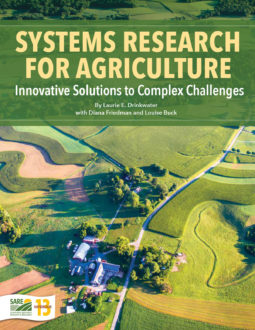After the team has developed a set of goals and objectives, the next step is to formulate the project (or experimental) plan. In this phase, the team plans the overall experimental design and specifies methods for implementation, analysis, and interpretation of results. Projects that generate results to be applied in farming systems should include a plan for conveying the information to stakeholders. Depending on the type of project and the nature of the research, try to frame questions or hypotheses to guide development of the experimental plan at this stage. See Box 3.1 for examples of systems-level hypotheses.
Box 3.1: Examples of Systems-Level Hypotheses for Agricultural Systems Research
- Biologically diversified agricultural systems are more resilient than less diversified systems.
- Agricultural systems designed to reduce greenhouse gas emissions and store soil carbon will have improved soil and water quality.
- Diverse crop and livestock systems have lower environmental and economic risk than monoculture systems.
- All energy and nutrient needs can be generated on-farm in a New Hampshire dairy system.
- Organic cash grain systems are economically competitive and have reduced greenhouse gas emissions per pound of grain produced compared to non-organic grain systems.
As with all research, the experimental design must be well suited to achieving the experimental goals. This can be challenging in collaborative projects when team members lack experience in designing interdisciplinary studies that address questions at the systems level.
During the experimental design phase, two common problems often arise. First, if the conceptual model does not accurately represent the system, it will be difficult to develop a systems-level hypothesis or an appropriate experimental design. If the research team is having trouble at this stage, it may help to reassess the logic and assumptions behind the conceptual framework and to revisit the project goals and objectives.
Second, differences in experimental and analytical approaches across disciplines may hinder the design process, especially if the team is composed of members who do not have experience in cross-disciplinary collaborations. If this occurs, have group members give presentations that explain their individual research approaches. These presentations should be specific to the project, describe the methods needed to address particular questions, and explain the rationale for using those methods. Taking time to exchange this information will help team members understand how other disciplines approach research and will greatly facilitate the experimental planning.
The experimental design phase generally has two planning stages. The first focuses on big-picture decisions about issues such as the research location and time frame and the types of agricultural systems and processes to be studied. Sometimes, the team will make big-picture decisions while defining the project goals and research questions.
The second stage involves decisions that are determined by the larger plan, objectives and available funding. These decisions usually focus on site selection criteria, plot size and configuration, and identification of variables to be measured.
